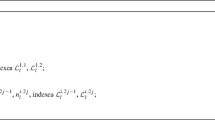Abstract
Because the similarity of gene sequence in structure usually leads to the similarity in function in bioinformatics, finding subsequences that have partial similarity with given bio-sequence in the database and presuming the function of queried sequence is work that is often needed completed in quantity. This paper presents a new bio-sequence search method which compresses index results based on sorting structure. The method on one hand reduces the space demand on index and improves space utilization rate, on the other hand does dynamic planning with the expanding of fragment vector in the same time to enhance filtering efficiency and reduce time complexity. On the premise of guaranteeing search result accuracy rate, the search efficiency is increased greatly.
Access this chapter
Tax calculation will be finalised at checkout
Purchases are for personal use only
Preview
Unable to display preview. Download preview PDF.
Similar content being viewed by others
References
Smith, T., Waterman: Identification of Common Molecular Subsequences. Journal of Molecular Biology 147, 195–197 (1981)
Huang, X., Miller, W.: A time-efficient, linear-space local similarity algorithm. Adv. Appl. Math 12, 337–357 (1991)
Altschul, S., Gish, W.: Basic local alignment search tool. Journal of Molecular Biology 215(3), 403–410 (1990)
Kahveci, T., Vebjorn, L., Ambuj, A.K.: Speeding up whole-genome alignment by indexing frequency vectors. Bioinformatics 20(13), 2122–2134 (2004)
Hunt, E., Atkinson, M.P., Irving, R.W.: A Database Index to Large Biological Sequences. In: VLDB, Roma, Italy, pp. 139–148 (2001)
Hariharan, R.: Optimal parallel suffix tree construction. In: 26th ACM Symposium on Theory of Computing, Montreal, Canada, pp. 290–299 (1994)
Colin, M., Jignesh, M.P., Shruti, K.: OASIS: An Online and Accurate Technique for Local-alignment Searches on Biological Sequences. In: VLDB Berlin, Germany, pp. 910–921 (2003)
Author information
Authors and Affiliations
Corresponding author
Editor information
Editors and Affiliations
Rights and permissions
Copyright information
© 2012 Springer Science+Business Media Dordrecht
About this paper
Cite this paper
Xiao, C., Huimin, T. (2012). A New Search Technology of Bio-sequence Similarity Based on Sorting Index. In: Wu, Y. (eds) Advanced Technology in Teaching - Proceedings of the 2009 3rd International Conference on Teaching and Computational Science (WTCS 2009). Advances in Intelligent and Soft Computing, vol 117. Springer, Berlin, Heidelberg. https://doi.org/10.1007/978-3-642-25437-6_120
Download citation
DOI: https://doi.org/10.1007/978-3-642-25437-6_120
Published:
Publisher Name: Springer, Berlin, Heidelberg
Print ISBN: 978-3-642-25436-9
Online ISBN: 978-3-642-25437-6
eBook Packages: EngineeringEngineering (R0)




